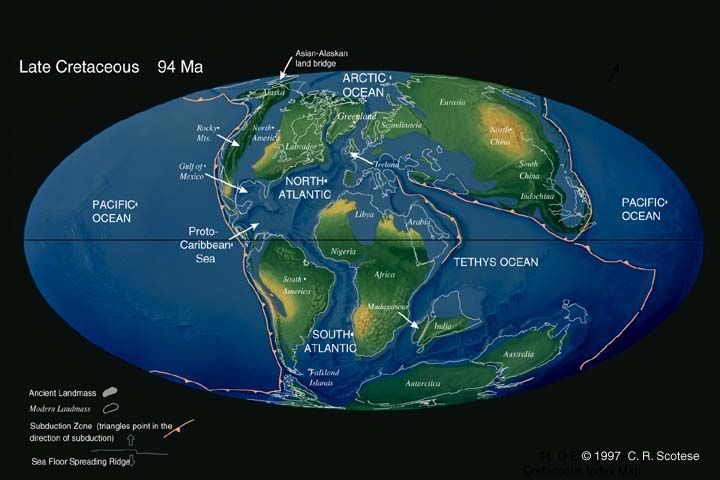Evening ladies and gents. Today's blog will look at how a species evolved in changing climatic conditions to become one of the top predators in its habitat, and it is not a mighty tyrannosaur that takes centre stage. Its a smaller theropod who goes by the name Troodon. Lets start off with the basics. By definition, members of the Troodon are small, bipedal carnivores, best known for their large brains and inferred cerebral capabilities. Found during the late Cretaceous, they weighed in at no more than 50kg. That's about twenty times smaller than the Gorgosaurus (centre right) in the picture above. It was their brain power that gave them a vast predatory arsenal, using speed and communication to hunt.
However, during the Maastrichian, climate fluctuations meant that the polar regions got colder and saw less daylight (Wolfe and Upchurch, 1987). And as a general rule, the colder it gets, the fewer predators you come across. This can be seen in Alaska's fossil record: fewer than one percent of the 3000 bones collected there show predator tooth marks (Gangloff, 2012). However, of the predators found in the arctic circle, Troodon is very well represented. This is where it gets interesting. The teeth this far north are twice as big as those found south. That means where looking at predators twice as big as they should be: nearing the 100kg mark.
Now, I'm not saying that these larger Troodon are the same species as their southern representatives, but they are of the same tribe, and thus extremely similar. This shows how climate has affected the small theropod, and it has responded accordingly. It's already large eyes meant it had no problem hunting in the perpetual night that surrounds the area for most of the year. And the probable feathered covered skin helped with heat retention. The interesting morphological change is the doubling of its mass. Surely having more mass means larger energy expenditure? It probably is the case. But being larger helps with heat rentention, as they now possess a smaller surface area to volume ratio compared to their smaller cousins. Put a feather coat on top of that and they were pretty toasty.
This doubling in size also means that it can tackle larger prey, which was abundant for the same body heat retention (check out the gigantothermy model for more info). Working together to haul down large Edmontosaurus for example, meant that Troodon was king of the Acrtic.
-http://blogs.smithsonianmag.com/dinosaur/files/2011/05/March-of-the-dinosaurs-promo.jpg
-http://www.clim-past-discuss.net/4/981/2008/cpd-4-981-2008.pdf
-Fiorillo, Anthony R.; Gangloff, Roland A. (2000). "Theropod teeth from the Prince Creek Formation (Cretaceous) of Northern Alaska, with speculations on Arctic dinosaur paleoecology". Journal of Vertebrate Paleontology 20(4): 675–682.
-http://books.google.co.uk/books?id=iriTYIpQV4IC&pg=PA100&lpg=PA100&dq=arctic+troodon+teeth&source=bl&ots=Q-pNtJu30w&sig=0DZe0Hcu99BPegpe_tChXLdhUEU&hl=en&sa=X&ei=bRuMUNitBebO0QXE1YDgDQ&ved=0CEIQ6AEwBQ#v=onepage&q=arctic%20troodon%20teeth&f=false
-http://3.bp.blogspot.com/-WbOR1Wk4x7E/UBspJOtFc-I/AAAAAAAABGE/zFaPmA2U0yk/s640/alaska2.png










